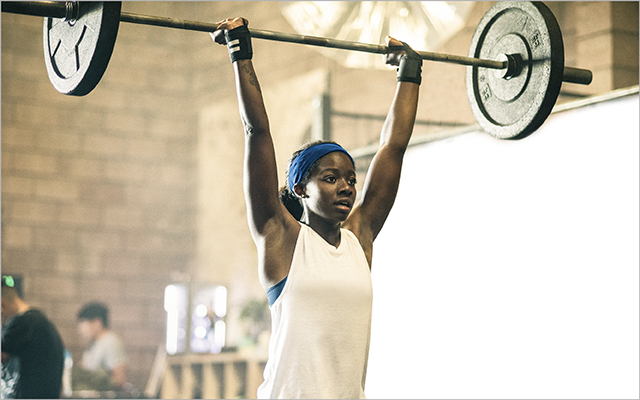My journey to lose almost half my body weight began in 2012 with a single mile. I was attending a conference in Charleston, S.C., and my coworkers wanted to visit the city’s historic district a mile away. Walking was painful, and I constantly stopped to catch my breath. Finally, I hailed a bike cab. “I’m so sorry,” I repeated to the struggling cabbie. I was mortified: At age 29, I couldn’t walk a mile with my friends.
I weighed 353 pounds. I was also diabetic and living with chronic pain from a car accident. Gastric-bypass surgery seemed like my only option.
Then one day in 2012, I drove by a CrossFit gym in my hometown of Roanoke, Va. People were running outdoors and lifting weights. I was intrigued, so I stopped in and talked with a coach, listing all the reasons I couldn’t exercise: I’d broken both legs, I had asthma, I couldn’t get up off the floor.
To my surprise, he knocked down each of my excuses — and was willing to help me if I would try.
With my doctor’s blessing, I put gastric-bypass surgery on hold and attended a free trial class at the gym. As the biggest person in the room, I worried people would laugh at me. But everyone was supportive, and the coaches scaled each exercise to my abilities. Afterward, I was sore but exhilarated — I couldn’t wait to go back. My journey toward better health had begun.
The Long and Winding Road
I’d always had poor eating habits and ailments to overcome. Family gatherings centered on food. In my teen years, I packed on pounds — even though I played sports and performed in the marching band. Adding to the problem was polycystic ovary syndrome (PCOS), a condition associated with weight gain, type 2 diabetes, and infertility.
Then, in March 2004, I was in a head-on car accident. Both my femurs were broken, my right tibia and fibula were fractured, and my left hip socket was cracked. Three people in the car that hit me died. I was lucky to be alive, but I felt guilty that I’d survived.
My recovery was hard. It took nine months, and I was confined to a bed or a chair for five of those. With titanium rods in both legs, I had to learn to walk all over again.
A year later, I returned to college, but I’d developed a broken persona. Because I was big, I wanted to hide; because of my injuries, every staircase or curb felt insurmountable. I became depressed and binged on fast food.
Even my dreams were broken. My parents had both served in the Navy, and I wanted to serve my country, too — but that possibility had vanished with my injuries.
Forward Motion
My self-esteem improved in 2010, when I got a job at a VA hospital where I could serve military veterans. But the job included leading visitor tours around campus, and I struggled for the breath to talk while I was walking. I wanted to do better, so in 2012, I dove into my new exercise and dietary regimens.
At first, my workouts didn’t look like everybody else’s. While others ran laps, I used the rowing machines to minimize the impact on my legs. Instead of doing burpees on the floor, I leaned against a weight bench. Gradually, I amped up the intensity; with time, I even learned to run again.
The community at the gym was a vital part of my journey. Instead of laughing at me, my new friends and my coach cheered me on. Because they believed in me, I started believing in myself.
I also changed my mindset around food. I’d cook a delicious steak-and-asparagus dinner that made it easier to forgo pizza. During the first month of my new fitness routine, I followed the Whole30 program, eliminating grains, sugar, soy, and dairy, which improved my PCOS symptoms. Within three months, my blood-glucose levels normalized. My type 2 diabetes has now been in remission for nearly seven years.
In that first year, I stuck with my new diet and exercise program, and I lost 88 pounds. But then I had The Big Setback. I hurt my back by lifting too much weight, so I had to go easy on my workouts for a while. Then I started sneak-eating: On social media, I posted photos of healthy meals — without mentioning I chased them with pints of ice cream.
By December 2014 I’d eaten my way back to 320 pounds, but I wasn’t fooling anyone, especially my coach. He challenged me to lose 100 pounds for the 2016 CrossFit Games Open 15 months later. I recommitted to my health quest by reporting daily on what I ate. I lost 50 pounds that year — short of the original target — but because I stayed flexible and shifted the timeline, I reached my 100-pound weight-loss goal in time for the 2017 Open. As difficult as setbacks can be, I’ve learned that they’re also opportunities for growth.
The following year, my trainer moved away and I started working with another coach. She became my accountability partner, especially for nutrition.
With her help, I was able to identify the foods that worked best for my body, and that has made all the difference in my weight loss. Beyond the work I did in the gym, forming a better relationship with food has been a game-changer.
Now I’m down to 193 pounds, but I’ve learned that the scale isn’t the only way to track results. Progress photos help me bridge the disconnect I experience when my image in the mirror doesn’t match how I look in my mind.
And I’m much stronger. I can do bear crawls across the gym floor and back without stopping; early on, I could manage only the length of one mat. My stomach doesn’t touch my car’s steering wheel anymore, I can fit in restaurant booths, and I can fly on airplanes without a seatbelt extension. Now I can hike, bike, paddleboard, kayak, and hopefully one day, skydive.
Taking control of my health and kicking type 2 diabetes were more meaningful to me than my weight loss. Today, I’m stronger mentally and emotionally than I gave myself credit for years ago. I’ve proved I can commit to myself.
I’m also grateful for my mobility. When I travel for work, I book an early flight so there’s time to explore the city on foot — just because I can. While I’m sightseeing, I often remember that Charleston conference when I couldn’t walk a mile. I’m not in pain like that anymore. I actually get to live my life.
Ginny’s Top 3 Success Strategies
- Own your choices. Don’t make excuses or play the victim. “I chose to eat too much,” Ginny says. “Admitting that no one is force-feeding me helps me combat secretive eating.”
- Focus on a greater “why.” “When I felt like blowing off the gym, I reminded myself it wasn’t about losing X number of pounds,” Ginny says. “It was about being vibrant and healthy.”
- Progress isn’t a straight, upward line. “Making changes is a series of ups and downs,” Ginny says. “A bad week — or weeks — of eating is part of the process, and you can change that right now, in the next five minutes, with the next choice.”
This originally appeared as “Stronger Than Yesterday” in the April 2019 print issue of Experience Life.




This Post Has 0 Comments